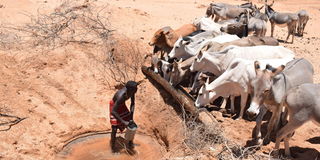Extreme droughts in Samburu disrupt livestock breeding cycles

A Samburu herdsboy watering livestock at Kom area on September 19, 2022. Extreme drought in the semi-arid region has disrupted the livestock breeding cycle and caused animal deaths
The cumulative impacts of four consecutive failed rain seasons in Samburu have disrupted livestock breeding cycles, resulting in livestock diseases, with the region under a prolonged drought emergency since 2019.
Samburu pastoralists, first affected by an invasion of desert locusts and then the coronavirus that disrupted livestock markets, are now struggling to survive amid a fourth consecutive season of drought. Samburu has received little rainfall since 2019 and most water pans and dams have dried up.
The National Drought Management Authority (NDMA) places the pastoral region at the alarm stage, with the drought rendering most families destitute. The depletion of browse and vegetation cover and the drying up of water sources have caused unplanned movement of livestock.
The current average return distance trekked is 16.6km, compared with 16.4 reported the previous month.
"The cumulative impact of four consecutive poor rainy seasons have resulted in poor livestock body conditions, high livestock mortality rates and disrupted breeding cycle," the NDMA says in its latest report.
"A larger proportion of cattle have been away from homesteads searching for better rangeland resources. These therefore have resulted in no milk production at the household level."
Only three households reported milk production of about two to three litres from camels, the agency said, adding that households are likely to continue experiencing scarcity of milk until the next good season is realised.
The ongoing dry spell, it said, has also resulted in a significant reduction in livestock herd size, caused by deaths of animals due to adverse drought impacts.
The NDMA says communities have reported a number of livestock deaths due to drought, and most herders are selling off their stock at throwaway prices. The report also says the proportion of remaining cattle have poor body conditions across the livelihood zones.
"Cattle market prices have retained a low pattern due to skinny body conditions occasioned by prolonged drought. The current average price was Sh13,700, which is an increase of 17 percent compared to last month’s price of Sh11,700," said NDMA.
The annual long rains, which usually fall between April and July, failed for the fourth successive season and the ongoing drought is showing no signs of easing. Communities now face a harsh life coupled with life-threatening hunger and competition with wild animals for resources such as water and pasture.
Reports indicate that more than 700,000 livestock have migrated to other parts due to scorched fields and lack of water. The ravaging drought has rendered most families destitute as a majority depend on nomadic pastoralism for their livelihoods.





